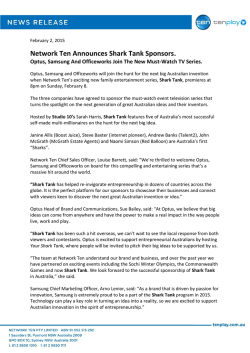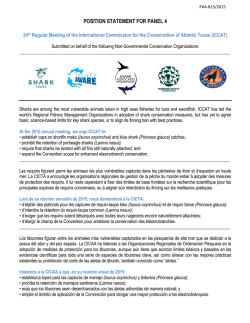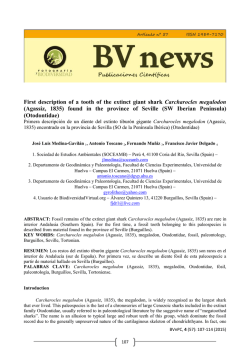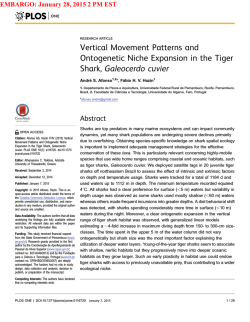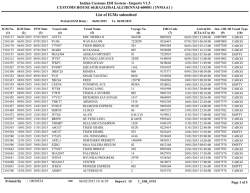
Dr. Felipe Galván-Magaña Biological studies on sharks and rays to
CENTRO INTERDISCIPLINARIO DE CIENCIAS MARINAS Biological studies on sharks and rays to recommend conservation or management measures in Baja California Sur Dr. Felipe Galván-Magaña 2000. What happen with Scalloped hammerhead in the Gulf of California? •What biological studies exist in Mexico to apply in shark fishing regulations or conservation ? • Fishing camps Las Barrancas Punta Belcher Punta Lobos San José del Cabo Punta Arenas El Sauzoso El Pardito Silky shark: Carcharhinus falciformis Ages: ♂ 14 : ♀ 16 years ♂142-260 cm TL; age groups: 3-14 years ♀88-230 cm TL; age groups: 2-16 years Maturity age : 8 years. Season: Only in Summer • ♀ D. gigas ♀ S.maturity at 180 cm TL; ♂ at 182 cm TL. japonicus 22.7% • Sexual22.04% rate 0.6 : 1 (M:H). •2-9 embryos. • ♂ Sperm storage C. hippurus 7.4% C. equiselis 7.8% P. planipes 28.4% Blue shark: Prionace glauca Ages 1 to 16 years with 70 to 290 cm TL. • Maturity age : ♂ 5-7 and ♁ 7-9 years. • Almost all the blue sharks are immature with size from 111-150 cm TL (4-7 years). •We found a lower growth rate in Baja California than the NE Pacific Ocean. • We foud this shark all year round. •Sexual rate: 1.6 M:1 H. •Sexual maturity: ♂ 190 /♁ 200 cm TL). •Mating and shark born during Summer. •Gestation: 12 months ( 27-33 embryos) . • Scalloped Hammerhead: Sphyrna lewini Fishing season : Juveniles in Winter (December to february). •Almost all sharks are immature (65-150 cm TL). •Bahía de la Paz is a nursery area for this shark. • D. gigas 23.3% Fish rests 25.5% Unidentified fishes 12.8% A. affinis 8.1% To know the poblational size, using the tagging method. O. banksii Calculate the time that sharks are in nursery areas (Bahia de la Paz y 11.8% Mazatlan). S. japonicus 9.4% To determine the distance and migration route. Mako Shark: Isurus oxyrinchus F 49 % Coryphaena hippur Dosidicus gigas 9 % Opisthonema libertate 10 % Fishes rests 14 % Ages from 0 to 18 years with 70 to 290 cm LT Maturity age : 7 years ♂ : 15 years ♁. Species found between 1 to 5 years with 90 to 160 cm TL Angel shark: Squatina californica Diplectrum spp. 4.1% P. margaritatus 6.2% Orgánic matter F 10.7% Fish rests Season:Winter-Spring •♀ mature at 74 cm TL; ♂ at 80cm TL •Embryos number: 4 – 6. •Mating and born: Summer • Using isotopes δ15N y δ13C indicate that principal food source is from benthic organisms in the coastal areas. 67.3% Whale shark: Rhincodon typus Las Ánimas Las Ánimas Tamaño de avistamiento IA RN FO LI CA DE Bajo ElElBajo Bahía norte Sin transectos Los Islotes BAHÍA DE L A PAZ Bahía centro Census by sea: Ruta navegación Isla Espíritu Santo SanJuan Juan San delalaCosta Costa de Isla Cerralvo Bahía sur Submarino AZ LLAAPPAZ MÉXICO O LF GO O FIC CÍ PA Censos aéreos: With transects NO ÉA OC Isla San José 1 2 3-10 107° 105° Tiburón ballena: Rhincodon typus Season of abundance: May-Jun and Sep-Nov. •They are segregated by size and sex. •Bahía de la Paz is a nursery area. •They feed on different zooplankton species considering their size •Depending the prey abundance, they use different feeding ways (sucction • or ram). •Bahia de Los Angeles (new study area) • Muestreos Zooplankton Carnívoros Herbívoros Omnívoros 13C y 15N 48 hrs a 60º White shark: Carcharodon carcharias Ongoing study •Isla Guadalupe Population structure Sexual rate Residence Sexual segregation •Genetic Population studies •Dynamic Migratory movements (short and large scale) Rap system,archival tags •Feeding behavior and C and N isotopes • SITUACION MUNDIAL Captura dirigida e incidental •Madurez tardía • Baja fecundidad • Declive poblacional • CITES (Convención sobre el Comercio Internacional de Especies Amenazadas de Fauna y Flora Silvestres) IUCN (Unión Internacional para la Conservación de la • PROFUNDIDAD Porcentajes Intervalos de Profundidad FISHERY ON RAYAS IN THE GULF OF CALIFORNIA Age and growth reproduction, feeding habits REPRODUCTION AGE AND GROWTH Ancho de Disco PROJECT WEB PAGE: WWW.TIBURONESYRAYASCICIMAR.COM ACKNOWLEDGEMENTS REPRODUCTION: Carcharhinus falciformis (Piloto): Mauricio Hoyos. Prionace glauca (Azul): Maribel Carrera. Squatina californica (Angel): Elisa Marqueda. Sphyrna lewini (Cornuda barrosa): Armando Soria, Marcela Bejarano. FEEDING HABITS: Prionace glauca (Azul): Berenice Aguilar. Squatina californica (Angel): Ofelia Escobar. Sphyrna lewini (Cornuda barrosa): Nallely Aguilar, Yassir Torres. Colombo Estupiñan, Luis Cedeño Alopias pelagicus. Carlos Polo, Marcos Calle, Liliana Rendon, Fabian Pacheco Isurus oxyrinchus (Mako): Paula Velasco. Hector Erazo Carcharhinus falciformis (Piloto): Alejandra Cabrera, Linda Barranco, Colombo Estupiñan, Luis Cede Sphyrna zygaena : Ruth Ochoa AGE AND GROWTH: Carcharhinus falciformis (Piloto): José Antonio Sánchez. Isurus oxyrinchus (Mako): Constanza Ribot. Prionace glauca (Azul): Pilar Blanco Sphyrna lewini (Cornuda barrosa): Jorge Zarate. ECOLOGY: Rhincodon typus ( Tiburón Ballena): Dení Ramirez, James Ketchum, Ana Hacohen. Carcharodon carcharias (Tiburón Blanco) Mauricio Hoyos, Mario Jaime Rivera, Pilar Blanco. Parasites: Oscar Méndez.
© Copyright 2025
